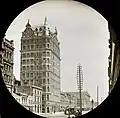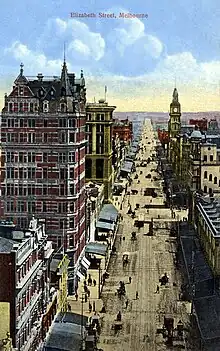| APA Building | |
|---|---|
 Photographed soon after completion | |
| General information | |
| Type | Office |
| Location | Cnr of Elizabeth Street & Flinders Lane, Melbourne, Victoria, Australia |
| Completed | 1890 |
| Demolished | 1980 |
| Height | |
| Antenna spire | 53 metres |
| Roof | 47 metres |
| Technical details | |
| Floor count | 12 |
| Design and construction | |
| Architect(s) | Oakden, Addison & Kemp with John Beswicke |
The APA Building was a skyscraper in Melbourne, Victoria, Australia; at 12 storeys and 53m to the tip of its corner spire, it was the tallest commercial building in Australia at the time of its construction in 1888–1890, later reputed (erroneously) to have been the world's tallest at the time.[1]
Originally known as the Australian Building (and also known as the Australian Property Investment Co or API Building), it was located at 49 Elizabeth Street, on the corner of Flinders Lane in Melbourne, and was notable for the way the Queen Anne style design lent it very vertical proportionals, enhanced by the steep roof, spires and gables of the top floors. It was Australia's tallest building until 1912, when it was surpassed by Culwulla Chambers in Sydney, and remained Melbourne's tallest until 1929.
It was demolished in 1980.
History
In the 1880s Melbourne was in the throes of the land boom,[2] fueled by easy credit and steep increases in the price of land, especially in the central city. Built by the Australian Property Investment Co, (or API), the announcement of the construction noted that it was said to be taller than any private building in London at the time, and would stand amongst the tallest in New York City and Chicago.[3] It was reputed to have been originally planned to have fifteen stories[4] (and an 1888 sketch shows an equally large building in the same style next door),[5] but it was built with 12 levels, the 12th one attic space and a caretakers flat.[6] The project was the brainchild of one of the directors of the API company, businessman and politician F T Derham, who had paid £65,000 for the site; the API then borrowed £400,000 for the construction from the London based Home and Colonial Assets Corporation Ltd.[7]
The API called a limited competition in November 1887, which was won Henry Hardie Kemp; at the time he was working at Terry & Oakden (partner Leonard Terry had died some years previously), where he was soon taken on as a partner, along with another senior architect, to form Oakden, Addison & Kemp. John Beswicke, who had worked for one of the API directors previously, had also been invited to submit, and was retained as an associate in the project as he had studied tall buildings, and is thought to have provided technical advice.[8] Construction began in 1888, and was completed some time in mid 1890.[9]
The Australian Building was constructed by local builder James Anderson who was a prominent member of The Builders and Contractors Association of Victoria. He built many notable buildings in Melbourne including the Hawthorn Town Hall, which still stands. Most others have been demolished.
The Australian Building was one of about 11 'massive edifices' of 8 to 10 floors built in the city at the height of the boom, of which only two survive.[10] They were made possible by the introduction of an hydraulic power system of pressurised water that could operate the lifts to great heights 'in complete safety'. They did not employ any new structural technologies however, relying on thick walls of load bearing brickwork, and internal structures of cast iron, wrought iron and timber. With the boom soon turning into a crash, these buildings remained the tallest for many years, and in 1916 a new building regulation was passed limiting buildings to 132 ft (40m).[1]
The building inevitably generated its own legends, for instance that three companies went broke sinking the 40m deep cylinders for the hydraulic lift pole, and that not long after completion, the bolt on one of the cylinders broke, sending the fortunately vacant lift speeding downwards.[11] Another from 1945 is that on the day of official inspection, the lift shot up uncontrollably only to bounce back from springs at the top, prompting many of the party to use the stairs on the way down.[12][13] The main legend is that it was the worlds tallest in 1890, for instance in the 1976 book Melbourne's Yesterdays, but there were a number of towers in New York City and Chicago in that year that exceeded it by at least one or two floors, plus architectural features.
Its great height and dominance in the streetscape led to it being the subject of many photographs and postcards in its first 20 years.
In 1920 the Australian Provincial Assurance Association, an insurance company, bought the building as its Melbourne base, and then renamed it the APA Building.[14]
The APA was Australia's tallest building until 1912, when the Culwalla Chambers was built in Sydney. This office building was constructed of reinforced concrete, and had 12 full office floors, with a facade height of 59m.[15]
The APA Building was Melbourne's tallest commercial building for 40 years, until the company decided to move, and purchased and remodelled another nine storey Victorian 'skyscraper' on the southeast corner of Collins and Queen Streets as its new headquarters, adding a very tall tower (largely for show) in 1929, which topped out at 76 m (250 ft).[16] This was also known as the APA Building, and was demolished in the late 1960s. Some time in the 1950s, the spire, turrets and gables of the top floors of the earlier APA Building were removed, leaving it with a truncated mansard roof.[17]
By the late 1970s, its historic importance was recognised despite its alteration, and it was classified by the National Trust in 1978.[18] It was also listed by the then Historic Buildings Preservation Council (now Heritage Victoria), but the owners then successfully argued for a demolition permit, on the basis of the large cost of upgrading to meet modern fire regulations.[11] It was demolished in mid 1980,[19] and replaced by a five-story office building.[20]
Architectural style
The building was designed by the architecture firm of Oakden, Addison & Kemp[21] in association with John Beswicke. The design has strong influences of the English Queen Anne revival, then a new style in Melbourne. This is seen in the use of red-brick with rendered stripes, and the picturesque turreted and gabled roofscape.
Claims to height
The APA Building has been variously claimed to be the tallest (or the third or fourth tallest) in the world in 1889, when in fact it was perhaps a distant sixth or seventh or more. Measured drawings held at the State Library of Victoria from 1980[22] show that it had 11 occupy-able floors, and a 12th attic floor with a caretakers flat, while plans reproduced in a thesis at the University of Melbourne show it had a roof height at the 11th floor at 41.5m, roof height of the top attic floor of 47m, and to top of the spire was 51m.[23] This is lower than, but comparable to a number of buildings in New York City and Chicago, built in that year or earlier.
The tallest in the world in 1889 was in Chicago, soon to be the home of all the world’s tallest buildings, where the tower portion of the Auditorium Building was 17 storeys and 72 metres (236 ft), while the 12-storey Rookery Building, completed in 1888, was 55 metres (180 ft) to the roof.[24] In New York, the tallest was the 12-storey Washington Building of 1887, which was 67 metres (220 ft) to the roof, plus attic and cupola; the 13-storey New York Times Building by George B Post was 57.3 metres (188 ft) to the top of its spire; and the adjacent 11-storey Potter Building completed in 1885 was 50.3 metres (165 ft) to the top of the roof, with pinnacles on top of that. The 1885 Hotel Chelsea was 43 metres (141 ft) to the top of the 12th storey, with decorative gables adding greater height.
It was only amongst the tallest in the world for 6 to 12 months, as towers in Chicago and New York continued to climb higher. The long demolished New York World Building was completed in 1890, with 13 floors plus a domed tower containing 6 more floors reaching as high as 94 metres (308 ft), and in 1891 the Monadnock Building in Chicago reached 60 metres (200 ft) over 16 floors, the tallest load bearing brick office building ever built.
Gallery
 APA Building sketch by H H Kemp
APA Building sketch by H H Kemp APA Building, c1890
APA Building, c1890 APA Building looking north up Elizabeth Street, c1900
APA Building looking north up Elizabeth Street, c1900 APA Building, Melbourne, 1978
APA Building, Melbourne, 1978
See also
References
- 1 2 "Skyscrapers". School of Historical & Philosophical Studies, The University of Melbourne. Retrieved 3 July 2015.
- ↑ "Land Boom". School of Historical & Philosophical Studies, The University of Melbourne. Retrieved 6 July 2015.
- ↑ "New Buildings in Melbourne: The Loftiest Structures in the City". The Argus. 14 June 1888. Retrieved 29 May 2017.
- ↑ Lewis, Miles (1995). Melbourne: The City's History and Development. City of Melbourne. p. 80.
- ↑ "Building for Australian Property & Investment Company Limd. c/o Elizabeth Street & Flinders Lane / Henry H. Kemp". Trove. Building & Engineering Journal 5 October 1889. Retrieved 29 May 2017.
- ↑ "Australian Building [i.e. Australian Property and Investment Company Building] [technical drawing] / P. McCluskey 1981". State Library Victoria. Retrieved 29 May 2017.
- ↑ Cannon, Michael. "The land boomers". search.slv.vic.gov.au. Retrieved 14 March 2020.
- ↑ "John Beswicke 1847 - 1925 Australian Heritage Architect The Book". www.johnbeswicke.com. Archived from the original on 26 February 2020. Retrieved 26 February 2020.
- ↑ "AUSTRALIAN PROPERTY AND INVESTMENT COMPANY". Argus. 1 March 1890. Retrieved 22 December 2022.
- ↑ School of Historical Studies, Department of History. "Skyscrapers - Entry - eMelbourne - The Encyclopedia of Melbourne Online". www.emelbourne.net.au. Retrieved 7 March 2020.
- 1 2 Latreille, Anne (3 March 1981). "The ups and downs in the world of lifts". The Age.
- ↑ "ARCHITECTURAL PIONEERING". The Age. 21 April 1945. p. 9. Retrieved 14 March 2020.
- ↑ The author of the 1945 account was H H Kemp, who may have been Henry Hardie Kemp, one of the original architects, who would have been about 85 years old at the time.
- ↑ "Australian Provincial Assurance advertisement". Sunday Times (Sydney): 27. 18 December 1921.
- ↑ "Culwalla Chambers". Search for heritage. Office of Environment & Heritage. Retrieved 7 October 2017.
- ↑ "City of Towers:Melbourne's Changing Skyline". The Argus. 12 February 1929. Retrieved 7 October 2017.
- ↑ "Australian Property Investment Co Building". Victorian Heritage Database. National Trust. Retrieved 24 April 2017.
- ↑ "Australian Property Investment Co Building". Victorian Heritage Database. National Trust of Australia (Victoria). Retrieved 7 October 2017.
- ↑ "Melbourne's first skyscraper bows out". The Age. 24 June 1980.
- ↑ "APA Building". Emporis. Archived from the original on 24 September 2015. Retrieved 6 July 2015.
- ↑ "Oakden, Percy (1845–1917)". Percy Oakden. National Centre of Biography, Australian National University. Retrieved 6 July 2015.
{{cite book}}:|website=ignored (help) - ↑ "Australian Building [i.e. Australian Property and Investment Company Building] [technical drawing] / P. McCluskey". search.slv.vic.gov.au. Retrieved 7 March 2020.
- ↑ Taylor, Michael (1960s). Marvellous Melbourne's Skyscrapers. Melbourne University Architecture Library: Undergrad Thesis.
- ↑ "Auditorium Building". Emporis. Archived from the original on 12 May 2015. Retrieved 24 April 2017.
Bibliography
- Granville Wilson, Peter Sands, Building a city: 100 years of Melbourne architecture, Oxford University Press (originally from the University of California), 1981.